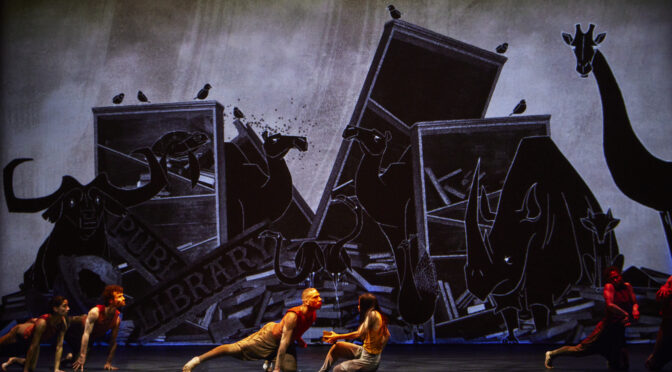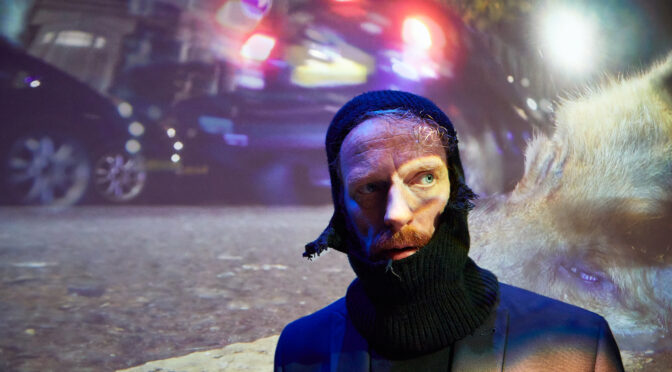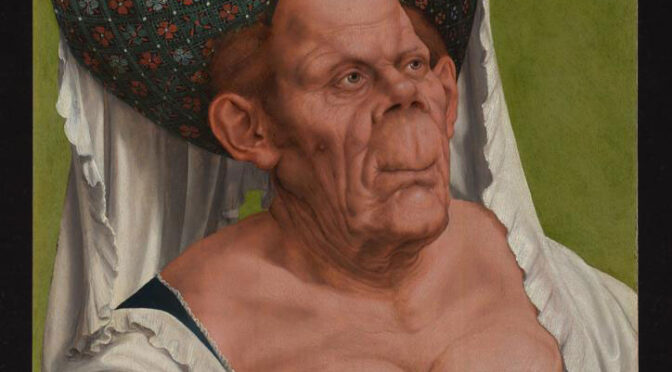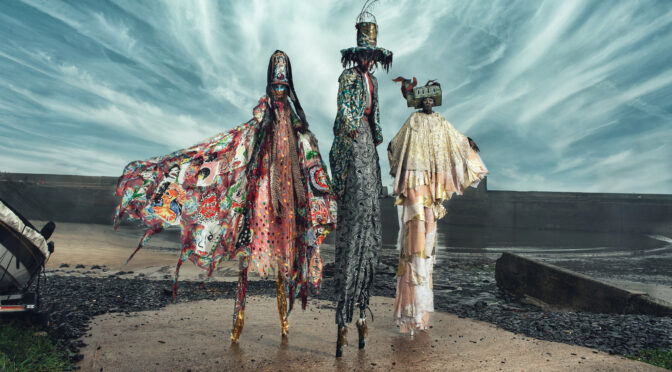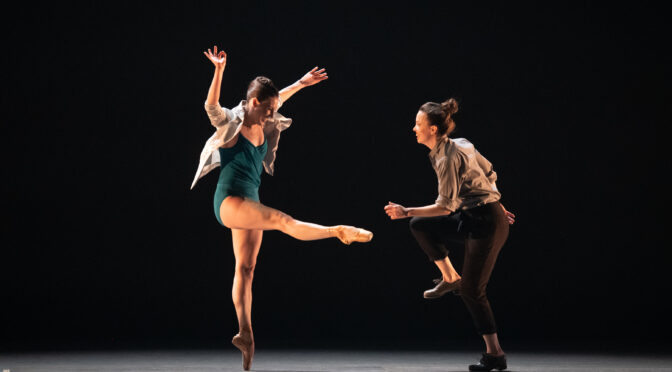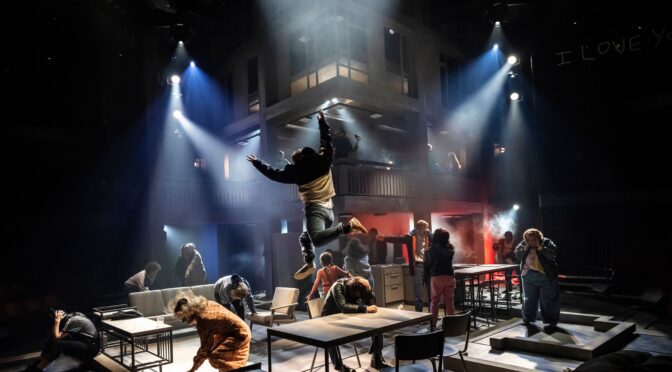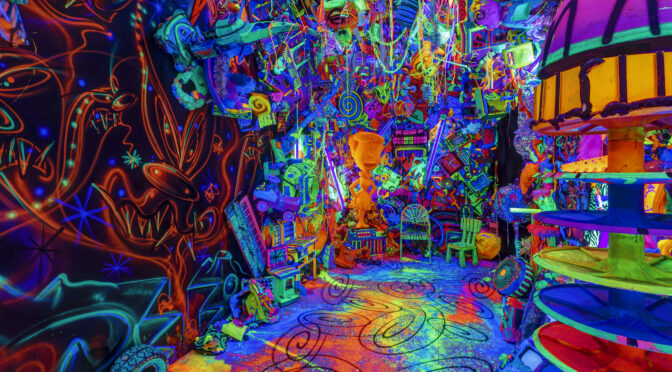Disney’s Jungle Book of my childhood: jovial, comic and full of dancing bears eating prickly pears, remains unrecognisable in Akram Khan’s dark re-telling of Rudyard Kipling’s tale. The focus is now on climate change and impending doom, whilst Mowgli’s fate feels closer to fact than fiction. Set in a post-apocalyptic city, submerged under water, the narrative essentially resembles the plight of a climate refugee fleeing her indigenous land and escaping rising sea levels. Mowgli is separated from her family when she falls from the raft she is sharing with her parents, but is then brought to the surface on the nose of a blue whale – a moment which contributes to one of a number of surreal and creative elements in an otherwise entirely contemporary and urgent story of climate-induced displacement and catastrophe.
This dance-theatre retelling of The Jungle Book combines numerous story-telling devices in order to deliver a powerfully emotive narrative. Dance, music, animation and voiceover come together to deliver an exciting and unique production, unparalleled in the London theatre scene at the moment. This pioneering quality is mostly delivered by YeastCulture’s incredibly beautiful animation, which adds layers to the story (both literally and metaphorically) without distracting from the choreography. A favourite moment features the elephants striding steadily across the front of the stage like an updated, contemporary moment from the Lion King. Their immense scale is effectively communicated when their digital selves interact with the real life performers on stage.
The weaker part of the production is the voiceover, which accompanies the animalistic dance-like movements. It felt confusing trying to work out, if the voices are in sync with the individuals’ movements, or whether trying to match the two up wasn’t the point, let alone which voice went with which performer, as every character was wore the same. This means that the voices actually distract from the beautiful dance. When the dancers are moving, the overall effect is profound and solemn, but when they are animated by sound, they are suddenly reduced to seemingly simpler characters with less emotive potential than when they are mute as physically expressive dancers. The storyline in the second half also becomes quite complicated and hard to follow, whilst the constantly appearing golden box carried by Mowgli remains elusive, other than being a reference to her past life with her family.
Jocelyn Pook’s music is fascinatingly eclectic and heady, adding suspense, atmosphere and emotion to the story. The tone of the music is melancholy, mesmerising and hypnotic, with a general mood evocative of chanting. The most beautiful and memorable piece for me was, ‘Where we Came From’, which combines traditional Indian singing with kyrie, eléison chants.
YeastCulture’s animation is one of the most captivating and exciting elements of the production. Transparent screens allow line drawings to come to life as animals, or rain to dash across the sky. Chil, the Kite, soars across the space and flashbacks of Mowgli with her mother simultaneously play out alongside Mowgli’s current situation amongst the animals in the concrete jungle of a dystopian city. These flashbacks add poignancy to the tragedy of Mowgli’s story and bring attention to the reality of separation at the heart of refugee struggles and the climate crisis. Another clever stage device is the use of props, as Kaa, the snake, was made up of a number of cardboard boxes, animated into a sinuous line by the dancers, and a mesmerising, lit-up sheet created a rippling body of shimmering water in one of the closing scenes.
The narrative crux of Akram Khan’s Jungle Book lies in the relationship between humans and the natural world. Mowgli’s love for the animals is anomalous as the only other human character, the ostracised hunter who has been rejected by his own kind, eventually turns destructive and kills Chil, the bird who has been faithfully watching over Mowgli.
At the heart of this production is a poignant mix of beauty and destruction, tenderness and violence. It examines the tension between survival and death and animal and human livelihoods. Khan’s message concerns the relationship between human and nature, with Mowgli representing hope and breaking the destructive trend of human destruction of the planet. Through a unique co-creation of mediums, the urgency of climate change is communicated in this emotionally engaging performance.
Image: Akram Khan’s Jungle Book reimagined ©Ambra Vernuccio
Review by Lucy Evans
Lucy’s passion for the arts began with drawing and painting at a young age and developed later on into a love of landscape painting and a degree in Art History, with a focus on Modernism and gender. Lucy has grown to love literature and acting in particular, and her experiences acting at the Edinburgh Fringe Festival have been formative, convincing her that performance can be an essential tool for communication and connection, as well as of course being a valuable source of entertainment.
Lucy’s latest review here Akedah-‘Two sisters pushing each other to the edge’ – Hampstead Theatre until 18th March (abundantart.net)
Tickets and information – https://www.sadlerswells.com/whats-on/akram-khan-company-jungle-book-reimagined/

